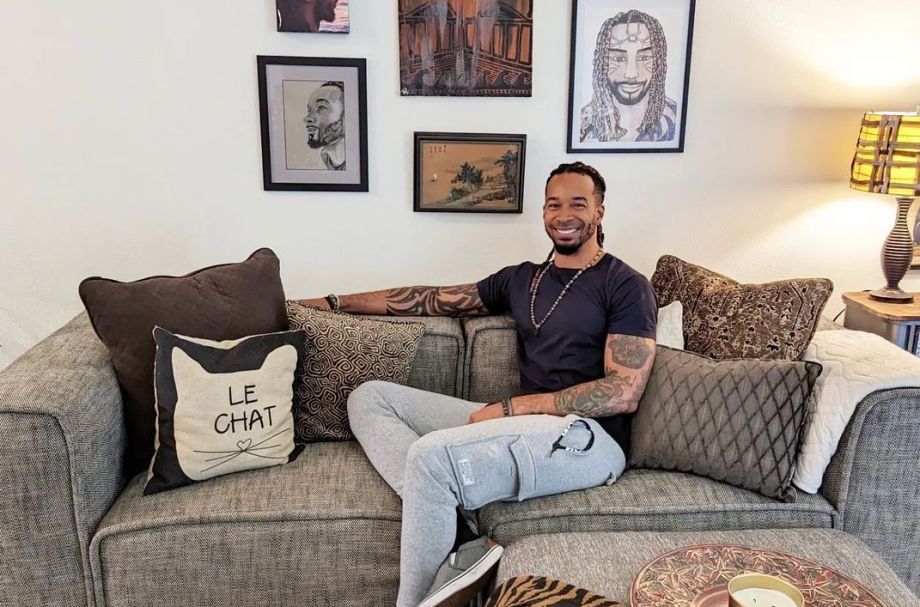The day that Bianca Moon gave birth to her daughter in 2016 was the same day that the father of her daughter kicked her out of their home in Highland Park, Michigan.
After spending a year and a half staying with friends, she and her daughter moved into a shelter that eventually led to a Section 8 housing voucher. When they finally moved into their current apartment in early 2019, all Moon had to bring with her was an air mattress and a lumpy old couch with a missing cushion that a friend gave her. Until the shelter connected her with Humble Design, that is.
Humble Design, a nonprofit furnishing homes for people emerging from homelessness, started in 2009 when its founder Treger Strasberg met a friend while volunteering at a nonprofit in Detroit.
“She confided in me one day that she was tired because she had slept in a homeless shelter that night,” Strasberg says. She helped her friend navigate the various social systems to find a house, but Strasberg soon came to find that housing was hardly where her friend’s needs stopped. “I went down to visit her at her house, and they were making little piles of winter coats to sleep on. When she had left her previous home because the rent was raised, she didn’t have money to put her stuff in storage so everything she owned went to the curb — her artwork, her grandma’s dishes, her TV, everything.”
When Strasberg called friends and neighbors to ask for any furniture they didn’t need to help her friend furnish her new home, donations of everything from beds and linens to furniture kept coming. Since then, Humble Design has blossomed from storing donations in Strasberg’s garage to warehouses in five cities from Chicago to San Diego.
To date, the nonprofit has furnished over 2,600 homes, facilitated the donation of more than 8 million pounds of furniture, and put more than 22,000 volunteer hours to work. Humble Design also diverts furniture and decor waste from landfills. The EPA estimates that more than 9.5 million tons of furniture and furnishings end up in landfills each year.
Throughout the years, Humble Design’s process has solidified. It starts with a caseworker or social worker who refers a person or a family to the nonprofit. The only real qualification is that the person is able to minimally work with Humble Design to be around to open the door on furnishing day.
“We don’t charge, so there’s no real downside for a homeless shelter caseworker to refer to us. And so many want to work with us because they very rarely get to offer good news to their clients,” Strasberg says.
From there, Humble Design’s signature approach hinges on treating each recipient like the design client that Strasberg – a graphic designer by trade – sees them as. “Humble Design is built on changing the narrative in the charity and homeless sector to start with dignity and end with dignity,” Strasberg says. “When it was founded with my friend, we furnished her home with all the things she wanted to see in her home. I treated her like a design client and that has not changed at all.” In 2019, Moon had the same experience. The process with Moon began the way that all of Humble Design’s client work begins, with thorough measurements and an inquiry into her tastes. “They came out and looked at the dimensions of my apartment. They asked me questions about what type of design I liked and wanted. They gave me the choices of what color schemes I wanted.” For Moon, it was a farmhouse aesthetic. Two weeks later, Moon and her daughter spent the day with a friend while Humble Design got to work. The process begins with cleaning the place from top to bottom before moving in the large pieces of furniture followed by the smaller, more decorative items like vases and flowers. Shower curtains are hung, family photos are framed, and everything is put away. Then, especially when there’s kids involved, the grand reveal happens after school is out. When Moon came back home a few hours later that afternoon, she was overwhelmed with emotion. “I wanted a farmhouse style, and it looked just like that. And my daughter’s room was exactly what she wanted, princess style,” Moon recalls. But it didn’t stop there: Her daughter’s room was also outfitted with toys and the bookshelves were stocked with books. “She was so happy,” Moon recalls of her daughter’s reaction. As a country, “we put a lot of money towards getting people into housing and rapid re-housing, which I completely agree with. But that’s not the end of the story. If you want people to stay in housing, they need wrap-around services to help them feel like they have a home,” Strasberg says. “It doesn’t give you a sense of permanence to have four walls and a floor. Think about the mental gymnastics you have to do every morning to say, ‘This is a good spot, I’m in a good space.’” Strasberg fields calls each week from people around the country looking to replicate Humble Design’s approach. “Today we have 30,000- and 60,000-square-foot warehouses,” she says. “But you don’t have to be us, because I wasn’t us when I started in my garage. If you want to furnish for someone in need, call a shelter, find someone in need, and go gather furniture for them.”
This article is part of Backyard, a newsletter exploring scalable solutions to make housing fairer, more affordable and more environmentally sustainable. Subscribe to our weekly Backyard newsletter.

Cinnamon Janzer is a freelance journalist based in Minneapolis. Her work has appeared in National Geographic, U.S. News & World Report, Rewire.news, and more. She holds an MA in Social Design, with a specialization in intervention design, from the Maryland Institute College of Art and a BA in Cultural Anthropology and Fine Art from the University of Minnesota, Twin Cities.
Follow Cinnamon .(JavaScript must be enabled to view this email address)

















